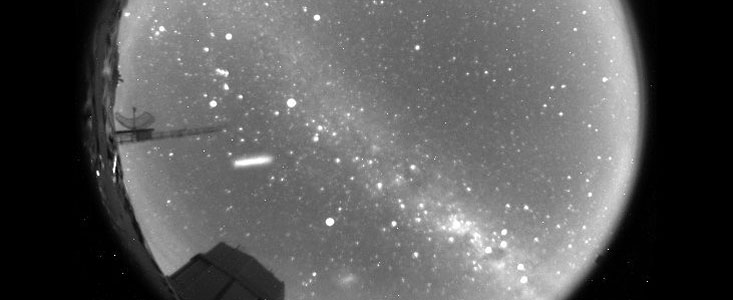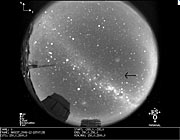Comunicato Stampa
It Is Too Early To Be Santa's Sleigh, Isn't It?
Flying Object Finally Identified
20 Dicembre 2006
Astronomers at ESO's frontline Paranal Observatory got a surprise on the morning of 18 December when looking at the observatory's all-sky camera, MASCOT. For about 45 minutes in the early morning, an object appeared first as a bright stripe then as a cloud that dissolved.
The discovery was made a little after 4 o'clock in the morning (7:00 GMT) by Christian Esparza, the operator of Antu, the first Unit Telescope (UT1) of ESO's Very Large Telescope who showed it to ESO astronomer Thomas Rivinius. Looking at the Mini All-Sky Cloud Observation Tool (MASCOT [1]), Esparza was surprised by the presence of a nebular object.
"I went outside to make sure this was not an optical effect," said Rivinius. "At the time I saw it, it had already taken the appearance of a cloud. In fact, it was as large and as bright as the Large Magellanic Cloud."
Having been convinced this was no fault on the camera, the astronomers went on a real detective chase to try to find out what the object could be. ESO's comet specialist Emmanuel Jehin quickly established that it could not be a meteor nor a comet. It was moving too slowly for a meteor - a meteor is seen for example on one of the images as a tenuous and fleeting streak - or for the International Space Station. Moreover, no other known satellite was supposed to pass above Cerro Paranal, in the Atacama Desert at that time. And why would the ISS or a satellite suddenly change shape from a bright point to a cloud?
Checking the Night Sky Live website, the astronomers then found out that the same phenomenon had been observed with the all-sky camera located at the site of Gemini South at Cerro Pachon, also in Chile and 600 km south of Paranal. Using these observations and a simple triangulation technique used, for example, in land surveys, it was then possible to measure the distance of the object. It appeared that the object was about 6000 km high when first seen and about double that in the later images. The object was moving away from Earth at tremendous speed!
Given this close distance, an astronomical object seemed unlikely and the only remaining possibility left to the scientists was to consider if a rocket had been launched. And, eureka!, it was quickly discovered that the same morning, about one hour before the object was seen from Paranal, the Japanese Aerospace Exploration Agency (JAXA) had launched a H-IIA rocket carrying the KIKU No. 8 (ETS-VIII) engineering test satellite, one of the largest geostationary satellites in the world.
The launch took place from the Tanegashima Space Center at 3:32 p.m. on December 18, 2006, Japan Standard Time (that is 3:32 a.m. Chilean time or 6:32 a.m. GMT). The launch vehicle flew smoothly, and, at 27 minutes and 35 seconds after lift-off, the KIKU No. 8 separation was confirmed. The Santiago station (in Chile) started receiving signals from the KIKU No. 8 at 4:27 a.m. Chilean Time.
Finally the mystery was solved: the object was most probably the 2nd stage of the launcher and the cloudy appearance at the end of the sequence most likely a dump of liquid fuel, made to avoid the explosion of the rocket in hundreds of scattered pieces, as a result of leftover fuel inside spent rocket stages. Having cracked the problem with his colleagues, Thomas Rivinius could finally go to sleep!
Note
[1]: MASCOT is the All-Sky Monitor of the Paranal Observatory. It delivers, every three minutes, images of the complete night-time sky, mainly to allow the detection of clouds.
Sul Comunicato Stampa
| Comunicato Stampa N": | eso0648 |
| Legacy ID: | PR 48/06 |
| Nome: | Very Large Telescope |
| Tipo: | Solar System : Sky Phenomenon : Night Sky Unspecified : Technology : Observatory |
| Facility: | Mini All-Sky Cloud Observation Tool, Very Large Telescope |
Our use of Cookies
We use cookies that are essential for accessing our websites and using our services. We also use cookies to analyse, measure and improve our websites’ performance, to enable content sharing via social media and to display media content hosted on third-party platforms.
ESO Cookies Policy
The European Organisation for Astronomical Research in the Southern Hemisphere (ESO) is the pre-eminent intergovernmental science and technology organisation in astronomy. It carries out an ambitious programme focused on the design, construction and operation of powerful ground-based observing facilities for astronomy.
This Cookies Policy is intended to provide clarity by outlining the cookies used on the ESO public websites, their functions, the options you have for controlling them, and the ways you can contact us for additional details.
What are cookies?
Cookies are small pieces of data stored on your device by websites you visit. They serve various purposes, such as remembering login credentials and preferences and enhance your browsing experience.
Categories of cookies we use
Essential cookies (always active): These cookies are strictly necessary for the proper functioning of our website. Without these cookies, the website cannot operate correctly, and certain services, such as logging in or accessing secure areas, may not be available; because they are essential for the website’s operation, they cannot be disabled.
Functional Cookies: These cookies enhance your browsing experience by enabling additional features and personalization, such as remembering your preferences and settings. While not strictly necessary for the website to function, they improve usability and convenience; these cookies are only placed if you provide your consent.
Analytics cookies: These cookies collect information about how visitors interact with our website, such as which pages are visited most often and how users navigate the site. This data helps us improve website performance, optimize content, and enhance the user experience; these cookies are only placed if you provide your consent. We use the following analytics cookies.
Matomo Cookies:
This website uses Matomo (formerly Piwik), an open source software which enables the statistical analysis of website visits. Matomo uses cookies (text files) which are saved on your computer and which allow us to analyze how you use our website. The website user information generated by the cookies will only be saved on the servers of our IT Department. We use this information to analyze www.eso.org visits and to prepare reports on website activities. These data will not be disclosed to third parties.
On behalf of ESO, Matomo will use this information for the purpose of evaluating your use of the website, compiling reports on website activity and providing other services relating to website activity and internet usage.
Matomo cookies settings:
Additional Third-party cookies on ESO websites: some of our pages display content from external providers, e.g. YouTube.
Such third-party services are outside of ESO control and may, at any time, change their terms of service, use of cookies, etc.
YouTube: Some videos on the ESO website are embedded from ESO’s official YouTube channel. We have enabled YouTube’s privacy-enhanced mode, meaning that no cookies are set unless the user actively clicks on the video to play it. Additionally, in this mode, YouTube does not store any personally identifiable cookie data for embedded video playbacks. For more details, please refer to YouTube’s embedding videos information page.
Cookies can also be classified based on the following elements.
Regarding the domain, there are:
- First-party cookies, set by the website you are currently visiting. They are stored by the same domain that you are browsing and are used to enhance your experience on that site;
- Third-party cookies, set by a domain other than the one you are currently visiting.
As for their duration, cookies can be:
- Browser-session cookies, which are deleted when the user closes the browser;
- Stored cookies, which stay on the user's device for a predetermined period of time.
How to manage cookies
Cookie settings: You can modify your cookie choices for the ESO webpages at any time by clicking on the link Cookie settings at the bottom of any page.
In your browser: If you wish to delete cookies or instruct your browser to delete or block cookies by default, please visit the help pages of your browser:
Please be aware that if you delete or decline cookies, certain functionalities of our website may be not be available and your browsing experience may be affected.
You can set most browsers to prevent any cookies being placed on your device, but you may then have to manually adjust some preferences every time you visit a site/page. And some services and functionalities may not work properly at all (e.g. profile logging-in, shop check out).
Updates to the ESO Cookies Policy
The ESO Cookies Policy may be subject to future updates, which will be made available on this page.
Additional information
For any queries related to cookies, please contact: pdprATesoDOTorg.
As ESO public webpages are managed by our Department of Communication, your questions will be dealt with the support of the said Department.



